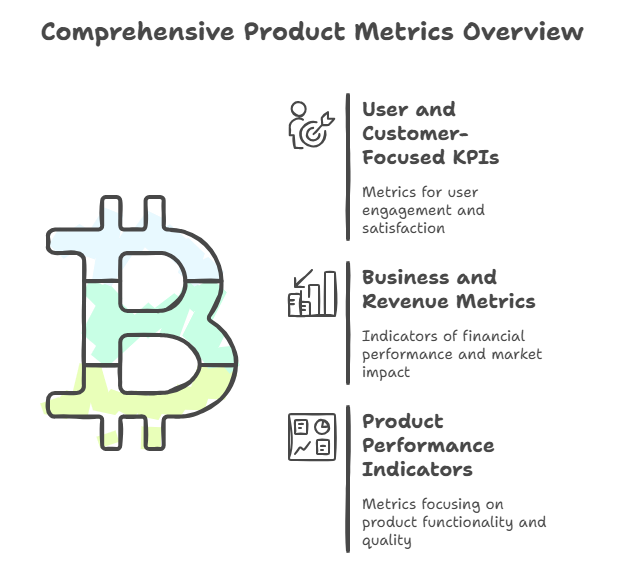How to Identify Key Product Metrics (KPIs) for Success
Learn how to identify the right product KPIs that measure user value, business outcomes, and product success with practical frameworks and examples.
What Are Product KPIs and Why They Matter
Key Performance Indicators, or KPIs, are critical, quantifiable measures of progress toward a desired result. For product teams, these metrics help determine if your product is creating the desired value for users, customers, and the business. According to Roman Pichler, KPIs measure if your product is creating the desired value for all stakeholders.
Choosing the right KPIs enables data-based decisions that increase your chances of achieving product success. They balance leading indicators that forecast future performance with lagging indicators that reflect outcomes achieved, guiding both planning and performance review.
Core Categories of Product Metrics

User and Customer-Focused KPIs
These metrics measure how well your product serves and retains users:
- Product adoption: How quickly and widely users embrace your product
- Customer satisfaction: Measures of user happiness and experience
- Customer retention: How well you keep customers over time
- Conversion rate: Percentage of users who complete desired actions
According to product management experts, these key product management KPIs include product adoption, customer satisfaction, and customer retention as fundamental measures of user engagement.
Business and Revenue Metrics
These indicators track financial performance and market impact:
- Revenue: Overall income generated by the product
- Time-to-market: How quickly you can deliver new features
- Customer lifetime value: Total revenue from a customer relationship
- Market share: Your product's position relative to competitors
Product Performance Indicators
These metrics focus on the product itself:
- Feature usage: Which capabilities customers actually use
- Performance metrics: Speed, reliability, and technical quality
- User engagement: Depth and frequency of product interaction
- Support ticket volume: Indicator of usability issues
A Framework for Selecting Your KPIs
Start with Your Strategic Goals
Good KPIs truly reflect and measure strategic priorities. Begin by understanding your product goals and what success looks like for your specific context. As the KPI Institute notes, good KPIs truly reflect and measure strategic priorities.
Ask these critical questions:
- What user problems are we solving?
- What business outcomes matter most?
- How do we define product success?
- What behaviors indicate value creation?
Align with Stakeholder Needs
Effective KPIs balance multiple perspectives:
- User goals: What makes the product valuable to end users?
- Customer goals: What do paying customers need to achieve?
- Business goals: How does this product contribute to company objectives?
- Product goals: What specific product outcomes matter?
Remember that whenever user, business, or product goals change, the indicators are likely to change too. Your KPIs should evolve as your product and market mature.
Apply the SMART Criteria
Ensure your selected KPIs are:
- Specific: Clearly defined and focused
- Measurable: Quantifiable with available data
- Achievable: Realistic given your resources
- Relevant: Directly tied to strategic objectives
- Time-bound: Measured within specific timeframes
Common Pitfalls to Avoid
Many product teams struggle with KPI selection. Watch out for these common mistakes:
- Vanity metrics: Numbers that look good but don't drive decisions
- Too many KPIs: Focus on 5-7 key metrics that truly matter
- Misaligned metrics: KPIs that don't connect to business outcomes
- Static measurement: Failing to adapt KPIs as goals evolve
- Data without context: Metrics without benchmarks or targets
Implementing and Tracking Your KPIs
Once you've identified your key product metrics, establish a consistent tracking system. Tools like Jira Software offer customizable dashboards to display key metrics, while tracking product management KPIs ensures data-driven decisions and a user-centric approach.
Establish regular review cycles to assess your KPIs against targets and adjust your product strategy accordingly. Compare your performance against internal benchmarks and, when possible, industry standards to gain meaningful insights.
Visualizing Your KPI Strategy
Creating a visual framework for your product metrics can dramatically improve team alignment and focus. Consider using ClipMind to map out your KPI relationships and ensure everyone understands how different metrics connect to product success. The platform's visual approach helps teams see the big picture while maintaining focus on what matters most.
Effective KPI identification isn't about tracking everything—it's about measuring what truly indicates product success for your specific context. By focusing on metrics that reflect user value, business outcomes, and product performance, you can make informed decisions that drive meaningful progress.
 ClipMind
ClipMind